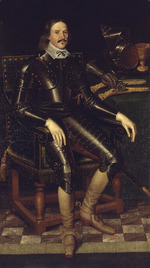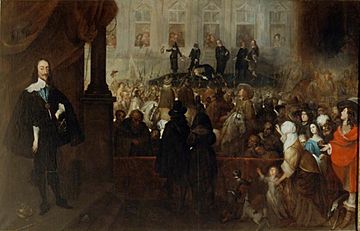Michael Livesey facts for kids
Quick facts for kids
Sir
Michael Livesey
|
|
|---|---|

Sir Michael Livesey
|
|
| High Sheriff of Kent | |
| In office 1655–1657 |
|
| Member of Parliament for Queenborough |
|
| In office September 1645 – April 1653 |
|
| Personal details | |
| Born | 1614 Eastchurch, Kent |
| Died | 1665 Rotterdam, Dutch Republic |
| Nationality | English |
| Spouse | Elizabeth (?-1665) |
| Children | Anne; Deborah (1634-?) |
| Occupation | Landowner, soldier, and Puritan activist |
| Military service | |
| Rank | Colonel |
| Battles/wars | |
Sir Michael Livesey (1614 - around 1665) was an important figure in English history. He was a Puritan activist and a Member of Parliament. He also served as a soldier in the Parliamentarian army during the Wars of the Three Kingdoms. These wars were a series of conflicts in England, Scotland, and Ireland.
Livesey is known for being one of the "regicides." This means he was among those who approved the execution of King Charles I in January 1649.
When the First English Civil War started in 1642, Livesey helped secure the county of Kent for Parliament. He raised a group of cavalry soldiers. He also worked in the local government. In 1645, he became a Member of Parliament for Queenborough.
During the Second English Civil War in 1648, he helped stop rebellions by those who supported the King. Livesey believed in a republic, where Parliament had the most power. He did not want to negotiate with King Charles I. After the King's trial, he was chosen as a judge.
Later, he became unhappy with the new government, called the Protectorate. However, he still served as High Sheriff of Kent in 1655 and 1656. After King Charles II was put back on the throne in 1660, Livesey was declared a "regicide." He had to escape to the Low Countries (modern-day Netherlands and Belgium). He died in Rotterdam around June 1665.
Contents
Who was Michael Livesey?
Michael Livesey was the only son of Gabriel Livesey and Anne Sondes. His family was a leading part of the local gentry in Kent. This meant they were wealthy landowners. His grandfather and father had both served as Sheriffs in different counties.
After his father died in 1622, his mother married Sir John Hayward. Livesey's family had estates in Hollingbourne and Eastchurch.
Livesey married Elizabeth Clinton-Fiennes. They had two daughters, Deborah and Anne. Anne later married Sir Robert Sprignell. Livesey's special title, called a baronetcy, was taken away in 1660.
Livesey's Role in the English Civil War
Before 1640, Livesey bought a special title called a baronetcy in 1627. He also became a Justice of the Peace in 1637. This meant he helped keep law and order. He was a strong Puritan, a type of Protestant. His marriage connected him to powerful people who opposed King Charles I. In 1642, he supported changes that Parliament wanted.
When the First English Civil War began in August 1642, most people in Kent supported Parliament. Livesey created his own group of cavalry soldiers. His unit took control of Rochester and Canterbury. He was part of the Army of the Southern Association. He helped capture Chichester in December 1642. He also served on the Kent County Committee, which managed local government.
In late 1643, a Royalist army moved into Hampshire and Sussex. These areas had important iron factories that made weapons for Parliament. Livesey and his cavalry joined other Parliamentarian forces. They worked to stop the Royalist advance. By January 1644, the Royalists were pushed back.
Livesey continued to fight in major battles. He was at Cheriton in March 1644 and Cropredy Bridge in June. Soldiers often did not want to fight far from their homes. Some of Livesey's soldiers left. He was cleared of any wrongdoing. However, he left the army in early 1645.
Livesey's Political Career
In September 1645, Livesey became a Member of Parliament for Queenborough. After the war ended in 1646, he did not want to negotiate with King Charles. He supported the army leaders against more moderate members of Parliament.
In December 1647, riots broke out in Kent. Livesey was sent to stop them. He stayed in South East England when the Second English Civil War began in April 1648. He helped put down unrest in Sussex. He also supported Sir Thomas Fairfax in the campaign that captured Maidstone in June.
Even after this victory, Kent remained a concern. Nine warships that Parliament controlled joined the King's son in Holland. On July 4, people asked Parliament to talk with the King again. On the same day, the Earl of Holland tried to take London with 400 cavalry. This attempt failed. Livesey's forces stopped the Royalists outside Surbiton.

The main Royalist army was defeated in August 1648. However, the revolt in Kent only ended in September. The Second Civil War was very harsh. Both sides executed prisoners. This war convinced Livesey and others that talking with the King was useless.
In December 1648, Parliament members who supported the King were removed. This event was called Pride's Purge. Livesey remained in the smaller group of MPs, known as the Rump Parliament. He was chosen to be a judge at the trial of King Charles I. He signed the document that approved the King's execution on January 30, 1649.
Over the next few years, Livesey became disappointed. Parliament's power was reduced. Then, it was replaced by the Protectorate in 1654. He focused on local politics instead. He served as High Sheriff of Kent in 1655 and 1656. When the Rump Parliament was brought back in May 1659, he supported the civilian leaders against the army.
After King Charles II was put back on the throne in May 1660, Livesey and his wife had to flee. They went to the Low Countries. Some stories say he was killed by people loyal to the King. However, this is not true. He likely died in Rotterdam around June 1665.
Images for kids


